In Which Mickey Mouse Has Grown Up A Cow
 Thursday, June 4, 2009 at 10:02AM
Thursday, June 4, 2009 at 10:02AM 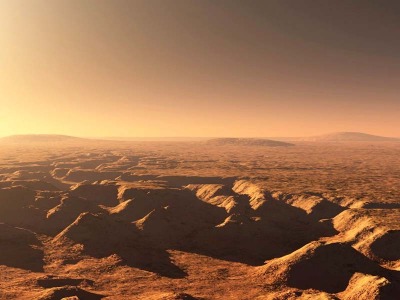
SCIENCE CORNER: Martian Edition
by MOLLY LAMBERT
Tharsis Montes is a range of three volcanoes in the Tharsis region of Mars. It is a plateau and the largest volcanic region on Mars. It consists of Ascraeus Mons, Pavonis Mons and Arsia Mons, which are arranged in that order from north to south. Another volcano, Olympus Mons, the tallest known mountain in the solar system, islocated northwest of the Tharsis volcanoes.

The three volcanoes that comprise Tharsis Montes: Arsia Mons is southernmost; Pavonis Mons is at center; Ascraeus Mons is at north.
Olympus Mons (Latin for "Mount Olympus") is the tallest known volcano and mountain in the Solar System. It is located on the planet Mars at approximately 18°N 133°W / 18, -133. It is three times taller than Mount Everest. Since the late 19th century — well before space probes confirmed its identity as a mountain — Olympus Mons was known to astronomers as the albedo feature, Nix Olympica ("Snows of Olympus"), although its mountainous nature was suspected.
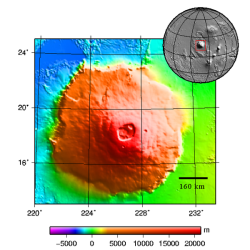
Olympus Mons
The central edifice stands 27 kilometers (around 16.7 miles/approx. 88,600 ft) high above the mean surface level of Mars (about three times the elevation of Mount Everest above sea level and 2.6 times the height of Mauna Kea above its base). It is 550 km (342 miles) in width, flanked by steep cliffs, and has a caldera complex that is 85 km (53 miles) long, 60 km (37 miles) wide, and up to 3 km (1.8 miles) deep with six overlapping pit craters. Its outer edge is defined by an escarpment up to 6 km (4 miles) tall, unique among the shield volcanoes of Mars.
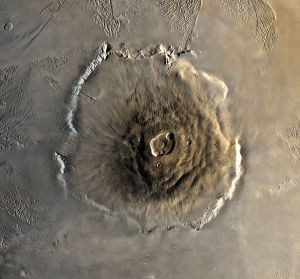
the aureole of Olympus Mons (no homo)
The volcano is surrounded by a region known as the Olympus Mons aureole (Latin, "circle of light") with gigantic ridges and blocks extending 1000 km (600 miles) from the summit that show evidence of development and resurfacing connected with glacial activity. Both the escarpment and the aureole are poorly understood. In one theory, this basalt cliff was formed by landslides, and the aureole consists of material they deposited.
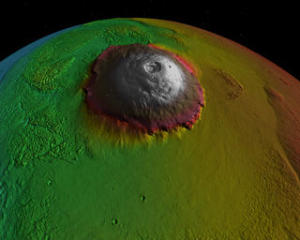
Olympus Mons is a shield volcano, the result of highly fluid lava flowing out of volcanic vents over a long period of time, and is much wider than it is tall; the average slope of Olympus Mons' flanks is very gradual. Based on crater size and frequency counts, the surface of this western scarp has been dated from 115 million years old down to a region that is only 2 million years old. This is very recent in geological terms, suggesting that the mountain may yet have some ongoing volcanic activity.
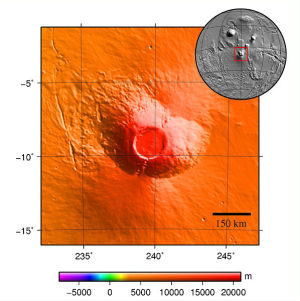
Arsia Mons
Arsia Mons is the southernmost of three volcanos (collectively known as Tharsis Montes) on the Tharsis bulge near the equator of the planet Mars. To its north is Pavonis Mons, and north of that is Ascraeus Mons. The tallest mountain in the solar system, Olympus Mons, is to its northwest. Its name comes from a corresponding albedo feature on a map by Giovanni Schiaparelli, which he named in turn after the legendary Roman forest of Arsia Silva.
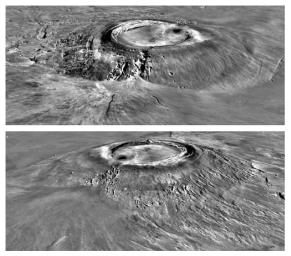 A repeated weather phenomenon occurs each year near the start of southern winter over Arsia Mons. Just before southern winter begins, sunlight warms the air on the slopes of the volcano. This air rises, bringing small amounts of dust with it. Eventually the rising air converges over the volcano's caldera and the fine sediment blown up from the volcano's slopes coalesces into a spiraling cloud of dust that is thick enough to observe from orbit. The spiral dust cloud over Arsia Mons repeats each year. Recent studies provide evidence for glaciers on Arsia Mons.
A repeated weather phenomenon occurs each year near the start of southern winter over Arsia Mons. Just before southern winter begins, sunlight warms the air on the slopes of the volcano. This air rises, bringing small amounts of dust with it. Eventually the rising air converges over the volcano's caldera and the fine sediment blown up from the volcano's slopes coalesces into a spiraling cloud of dust that is thick enough to observe from orbit. The spiral dust cloud over Arsia Mons repeats each year. Recent studies provide evidence for glaciers on Arsia Mons.
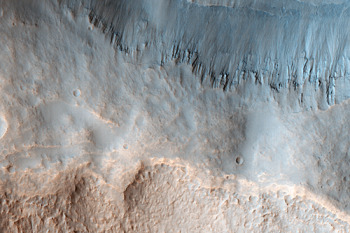
As of 2007 seven putative cave entrances have been identified in satellite imagery of the flanks of Arsia Mons. Nicknamed "the seven sisters" they have been informally dubbed Dena, Chloë, Wendy, Annie, Abbey, Nikki, and Jeanne and resemble "skylights" formed by the collapse of cave ceilings.
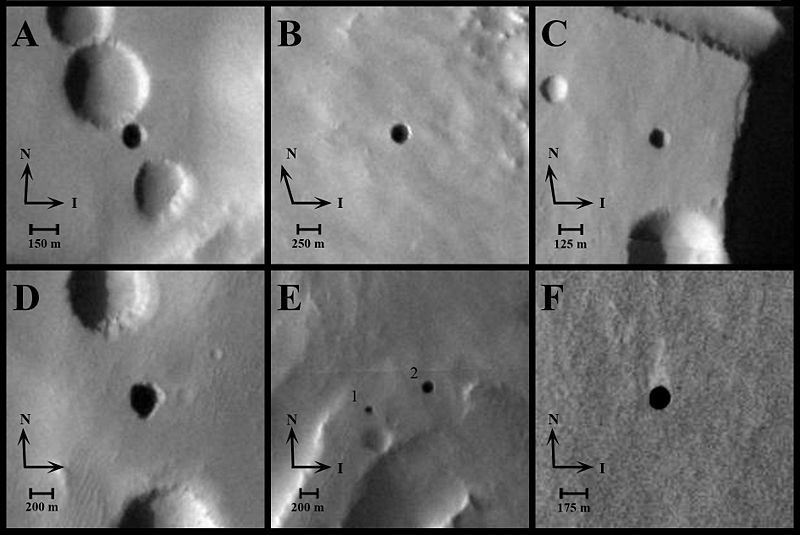
 cave entrance on Martian volcano? portal to another world?
cave entrance on Martian volcano? portal to another world?
From day to night, temperatures of the circular features change only about one-third as much as the change in temperature of surrounding ground. While this is more variable than large caves on Earth, it is consistent with them being deep pits. How deep they go and whether they harbor any life remains to be seen.
Molly Lambert is the managing editor of This Recording. She tumbls here.
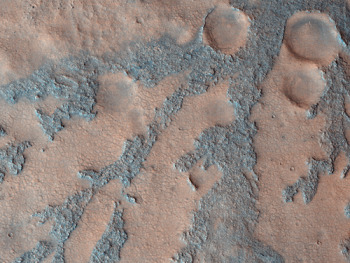
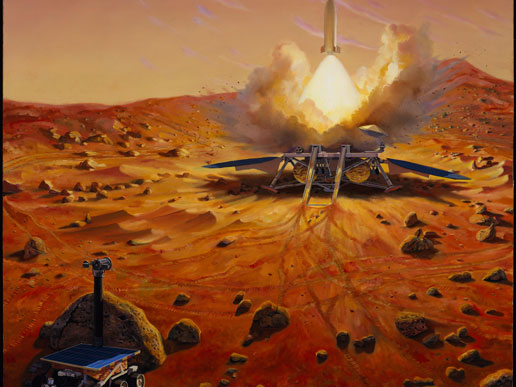
"Raindrops" - The Rumble Strips (mp3)
"Happy Hell" - The Rumble Strips (mp3)
"Not the Only Person" - The Rumble Strips (mp3)
rumble strips website

 mars,
mars,  molly lambert,
molly lambert,  science-corner
science-corner 




























